Blind Tasting Sheds Light On Wine Perceptions and Preferences
The Uncorked Kitchen & Wine Bar held its first-ever class on “How To Blind Taste” in early January. And the results were, well… eye-opening.
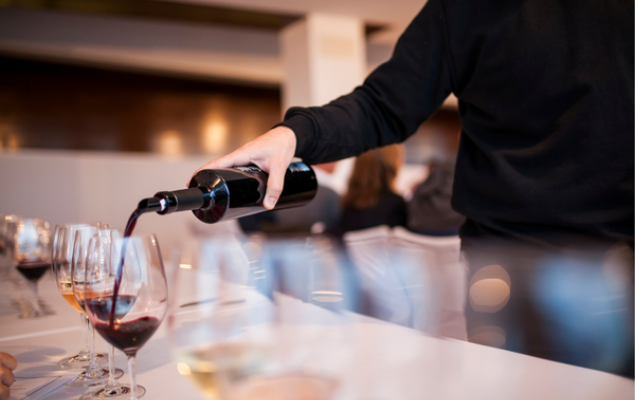
Blind wine tasting is the practice of making associations between the sight, smell, and taste of a wine to the varietal (and even region) that the wine derived from without knowing what it is in advance. This uses deductive methods, a process of elimination that first has you focus on what the wine can’t be in order to narrow your consideration of what it could be.
This is actually a lot harder than it sounds, and it sounds hard. Wine, like any taste, is very personal. Everyone tastes and experiences things differently, with different perceptions and preferences.
But… different types of wine have unique characteristics they typically share. Learning what they are, and how to identify them, is a useful element of wine appreciation. That means not just identifying tastes and aromas, but also structure (dry, sweet, acidic, etc.).
To aid us beginners in that effort, we were given a cheat sheet of sorts listing five whites and eight reds along with their taste and structure characteristics. We then had to match those against the actual two whites and four reds that we sampled.
Even with that assistance, the results were… humbling. Not discouraging, however. The class was less an exercise on how to show off wine knowledge at a dinner party and more about sharpening your attention to what it is you’re experiencing when you do drink wine.
There was more discussion in this class about taste and structure than any other I’ve attended, both with our instructor Michelle and with each other. Attendees were introspective and really thinking about what it was they were drinking rather than mentally cataloging the different types of winemaking methods between new and old-world wine production.
Ultimately, it’s to better enjoy wine.
There are several steps to evaluating wine, as set by the Court of Master Sommeliers
- Sight / Color
- Aroma
- Flavor
- Structure
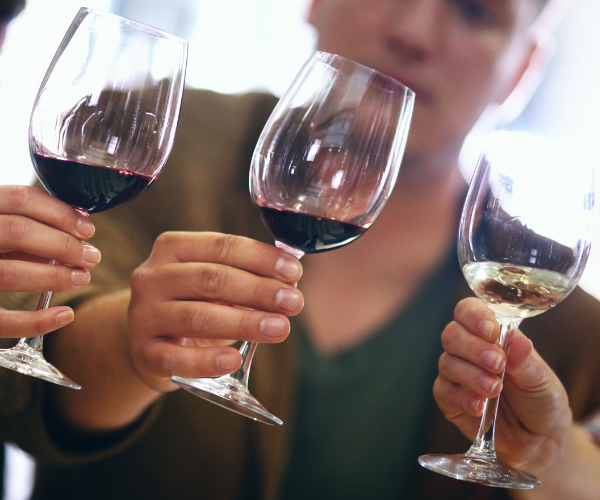
Sight
Tilt the glass at a 45-degree angle, preferably against a white background, and examine the color. Is it clear, or dark? Is the color at the rim different than in the center? When you swirl the wine in the glass, does it leave thick streaks along the sides?
All these details give clues to age, varietal, alcohol content, and structure. For instance, light-bodied white wines will likely be more acidic. Full-bodied reds likely are lower in acid but high in tannins.
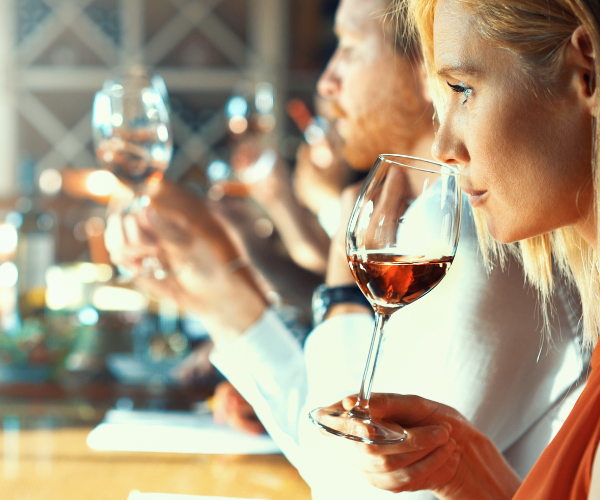
Aroma
Swirl the wine in the glass and stick your nose in there for a big whiff. What are you smelling? Red fruit (strawberry, cranberry) or dark fruit (plum, blackberry), or stone fruit (apricot, peach)? What other smells aside from the fruit are there? Grassy and herby, or earthy and wet, or stone? The goal is to name two fruits and two other aromas. The result gives indications as to the varietal of wine it might be or how it was produced (i.e. Pinot Noirs tend to have more red fruit aromas. Butter aromas in whites indicate oak aging).
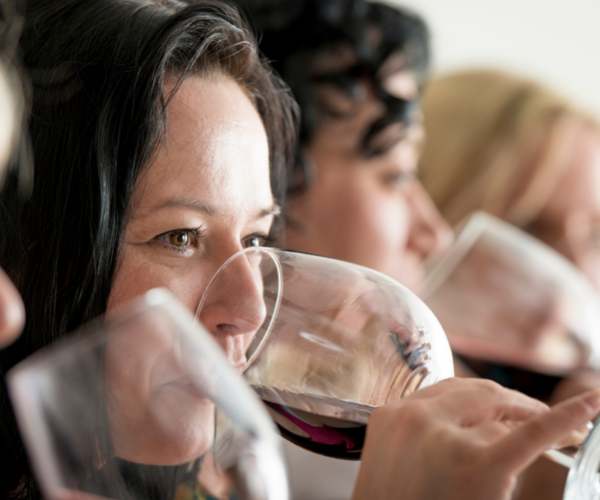
Flavor
Ah, finally the good part. Obviously, you should determine whether you like the wine or not, but also take a moment to break down these details so you can define what it is you like, and what you don’t, and put a name to both. Check on dryness versus sweetness. How ripe does the fruit taste? Is it fruit-forward or more subdued and herbaceous?
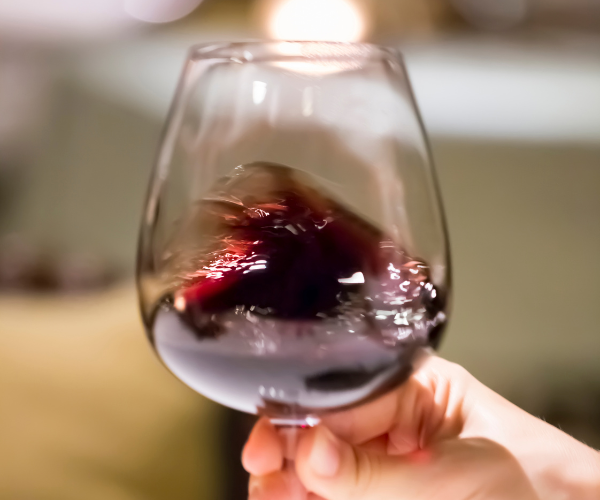
Structure
Getting past the flavor gets you to the structure, or “feel” of the wine. Is it full or light-bodied? Rounded or thin? Is it acidic (your mouth will water if so)? For reds, is it tannic (does your mouth feel like you ate a sweater)? Is your chest burning a bit (if so that means higher alcohol)?
Doing this at home with a bottle you just opened is a good way to start. Doing it with six or more glasses of different wines is a lot harder. After glass number four, your palette may get burned out. Mine did.
But the important thing to remember throughout all this is why you’re doing this in the first place. Blind tasting helps focus the mind and your attention on what you’re experiencing and drinking. It emphasizes the mindful consumption of wine rather than just reacting to it.
Sure, it can be difficult to put the sensations you experience with wine into words and terms that others will understand. Having a list of options and phrases in a class helps focus that process. Having an instructor walk you through what different sensations to look for and what they mean in terms of wine composition helps even more.
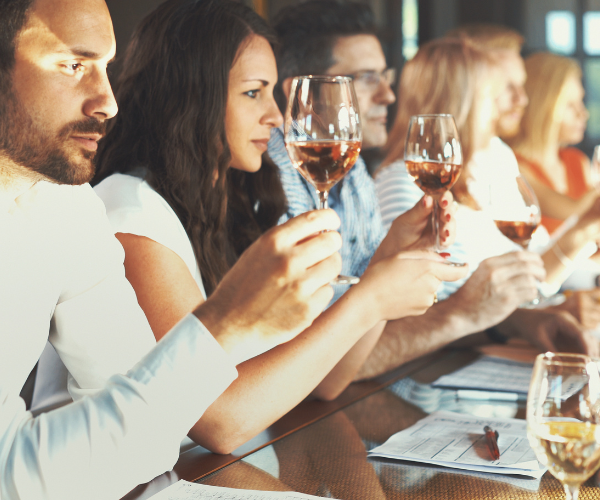
Yes, it’s hard. But blind tasting forces you to interpret your sensations and struggle to find the words to identify each characteristic. It’s a major step outside your comfort zone, and that’s where all progress is made.
Getting it wrong is not only OK… it’s expected. Anyone who attends a class like this and gets it all correct probably didn’t need to be in the class in the first place. In fact, getting it wrong is more insightful, and teaches a longer-lasting lesson. You remember more from your mistakes than your successes.
That’s why when some people guessed a Syrah was a Sangiovese, our instructor Michelle didn’t say “you’re wrong.” Instead, she said, “Here are the reasons why this isn’t a Sangiovese.”
Knowing why you don’t know something provides clarity and a path to knowledge. And with a confusing and complex world like wine, the more clarity the better.
I’ve never been happier about being wrong. Or at least that’s what I keep telling myself.
want to learn more about wine, wine appreciation, wine pairing, and more?
Check out the Uncorked Kitchen & Wine Bar event calendar for the next wine tasting and event coming up soon.

Antony Bruno is a Colorado-based veteran storyteller, writer and editor. After 30 years of writing about the intersection of technology and culture, he’s spending the next 30 writing about food, wine, travel, and adventure.
Hours
Closed Monday
Tuesday-Friday 3pm–10pm
Saturday 12pm-10pm
Sunday 12pm-6pm
HAPPY HOUR
Tuesday-Friday 3pm–6pm
Sunday 12pm-6pm
